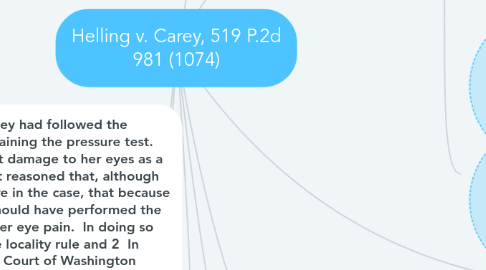
1. Rule of Law: "What usually is done may be evidence of what ought to be done, but what ought to be done is fixed by a standard of reasonable prudence, whether it is usually complied with or not." (Supreme Court ruling) Thus the supreme court determine that the rule of law did not apply to what was simple negligence because the defendant performed to the standard of the profession, however, they did not comply with what a prudent physician would have done which is to check the eye pressures even though the risk was low.
2. Analysis/Application: The defense held that they had followed the appropriate clinical standard of care in not obtaining the pressure test. The Plaintiff held that she sustained permanent damage to her eyes as a result of the defendants negligence. The court reasoned that, although the physician performed to the standard of care in the case, that because the test was inexpensive and very safe, they should have performed the test in order to rule out a treatable cause for her eye pain. In doing so the court expanded the law by 1. widening the locality rule and 2 In holding to this level of prudence, the Supreme Court of Washington places the level of liability of the physician to one of Strict Liability. Strict liability is holding the defendant liable without a finding of fault. The courts usually apply strict liability to cases where there is considerable risk involved. In this case the most compelling fact was comparing the cost and safety of performing the diagnostic test to the risk of missing a treatable diagnosis. They found the defendants should have chosen to rule out a rare diagnosis because of the consequences of missing the diagnosis. The most interesting point of this case is in the statement by the court "Courts must in the end say what is required; there are precautions so imperative that even their universal disregard will not excuse their omission." This tells me that the court felt they could disregard the standards of practice if they felt the personal prudence of strict liability applied. They did not consult or review the experts in deciding the case. This, in my eyes, is a very dangerous precedent that the courts can determine the appropriateness of medical treatment without consulting the experts. Helling v. Carey, Caveat Medicus D. Clay Kelly, Gina Manguno-Mire Journal of the American Academy of Psychiatry and the Law Online Sep 2008, 36 (3) 306-309;
3. Conclusion: the Supreme Court of Washington reversed the decisions of the trial and Appellate Courts and remanded the case back to the trial courts to determine damages only.
4. Importance: This case has influenced the locality rule. The locality rule implies, as it applies to medical malpractice cases, suggest that the standard should be based on the local standard of the area. Over the decades the locality rule has changed both with the advent of improved communications across the country, but also with the advent of national guidelines. The issue with using national guidelines in the courts are that, as with, all science they are imprecise. They often rely on anecdotal evidence and consensus of the writers of the guideline and not on well tested scientific data. Often times, there is more than one set of guidelines for a given disease process. From the Kelly article, Recupero cites an article published in the Annals of Internal Medicine,19 which indicates that in cases actually filed in court “attorneys used CPGs more frequently for inculpatory than exculpatory purposes” (Ref. 3, p 296).
5. Facts:
5.1. Parties: Plantiff is Barbara Helling a 32-year-old female with primary open angle glaucoma. Defendants are Dr. Carey and Dr. laughlin, ophthalmologists who treated Mrs. Helling from 1959 until October, 1968.
5.2. What Happened: Mrs Helling was initially evaluated for a complaint of nearsightedness in 1959 and was fitted for contact lenses. She returned to see the physicians in September 1963 with complaint of irritation of her eyes from the contacts. She was seen then seen on 9 occasions from October, 1963 through October, 1968. Until the October '68 visit it was felt her problems were related to her contacts. In October '68 the physician performed an eye pressure test and field of vision test for the first time, documenting open angle glaucoma. At that time her peripheral vision and her central vision were found to be significantly decreased.
5.3. Procedural History: August 1969 the plaintiff filed a complaint alleging permanent damage to her eyes secondary to negligence.
5.3.1. Trial court entered Judgement for the defendants following a defense that Both the defense and plaintiff medical experts testified that routine pressure tests are not standard of care for the profession on patients under the age of 40 because the risk (1/25000) is so low in her age group.
5.3.2. The plaintiffs Appealed and Appellate court upheld the decision of the trial court.
5.3.3. the case was overturned by the Supreme Court of Washington. "Courts must in the end say what is required; there are precautions so imperative that even their universal disregard will not excuse their omission." 83 Wn.2d 514 (1974) 519 P.2d 981 MORRISON P. HELLING et al., Petitioners, v. THOMAS F. CAREY et al., Respondents. No. 42775. The Supreme Court of Washington, En Banc. March 14, 1974.

